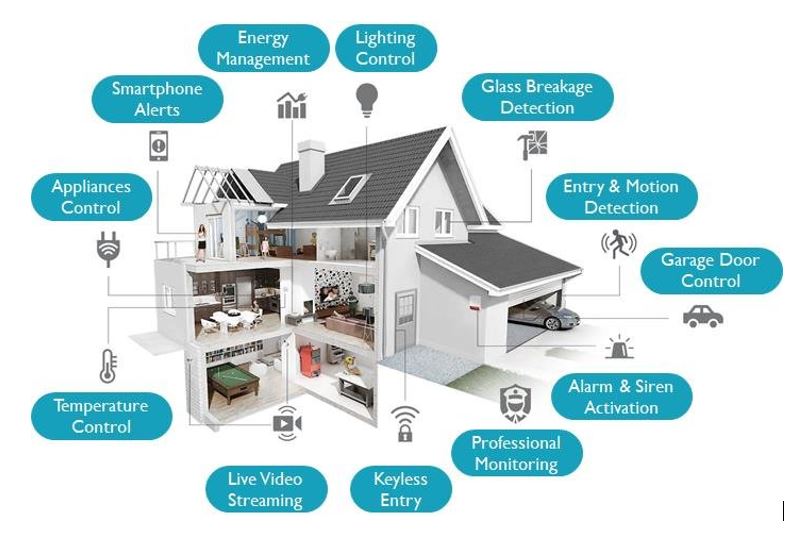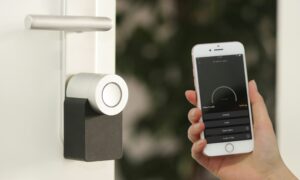In the ever-evolving landscape of modern living, the concept of homes has emerged as a revolutionary stride towards convenience, efficiency, and sustainable living. As technology continues to make profound advancements, its integration into various aspects of our lives becomes increasingly pronounced. One such remarkable integration is witnessed in the realm of home construction and design, giving birth to the concept of homes and paving the way for a harmonious blend of innovation and creativity. This integration includes the installation of devices and equipment which is done according to a precise timeline during the construction process; for more information on this topic, check out this page: https://housebouse.com/
I. Definition Of Smart Homes
At its core, a smart home is more than just bricks and mortar; it’s a living space imbued with intelligence, designed to enhance the quality of life for its inhabitants. A smart home is equipped with an array of interconnected technological devices and systems that collaborate to automate and simplify tasks that were once mundane and time-consuming. These devices range from smart thermostats that regulate temperature based on occupants’ preferences and presence, to voice-activated assistants that can dim lights, play music, and even provide weather updates with a simple vocal command.
The essence of a smart home lies not just in its technological prowess, but in its ability to adapt and learn from the behaviours and preferences of its occupants. Through machine learning algorithms, homes can anticipate the needs of the inhabitants, whether it’s adjusting lighting to match the time of day or preheating the oven based on cooking schedules. This level of responsiveness not only saves time but also contributes to energy conservation and a more streamlined lifestyle.
A. Role Of Technology In Modern Construction
In the realm of modern construction, technology has transcended its conventional role as a mere tool and has become an integral partner in the creative process. From inception to completion, technology is now a driving force that shapes the very foundations of architectural innovation. Building materials infused with smart capabilities, such as energy-efficient windows that tint automatically in response to sunlight, exemplify how technology is redefining construction norms.
Gone are the days when construction was a linear and isolated process. With the advent of Building Information Modeling (BIM) software, architects, engineers, and construction teams can collaborate seamlessly in a virtual environment, anticipating challenges and optimising designs before a single brick is laid. This not only reduces construction time and costs but also allows for a more precise execution of complex design elements that define the modern aesthetic.
B. Integration Of Creativity And Technology In Smart Home Design
The integration of creativity and technology is perhaps most evident in the design of homes. Architects and interior designers are now tasked with a dual responsibility: to envision spaces that are not only visually appealing but also attuned to the technological needs of the occupants. This marriage of artistry and functionality has given rise to a new era of design possibilities.
Smart home design encapsulates the seamless integration of technology into the very fabric of the living space. For instance, recessed lighting can be embedded with colour-changing LEDs that cater to different moods, while hidden speakers can deliver immersive audio experiences without compromising the aesthetics of the room. Furthermore, the placement of smart sensors and security cameras can be strategically concealed within the design, ensuring that the technology remains unobtrusive yet highly effective.
The design of homes also extends beyond the walls, encompassing the outdoor landscape. Automated irrigation systems that adjust water usage based on weather forecasts, or solar panels that are seamlessly incorporated into roofing structures, demonstrate how technology can be harnessed to create sustainable and visually appealing exteriors.
II. Creativity Meets Technology: Architectural Design
In the realm of architectural design, the synergy between creativity and technology has birthed an era of unparalleled innovation. homes today stand as testaments to the harmonious marriage of form and function, where cutting-edge technology seamlessly integrates with visionary design principles to create living spaces that are not only intelligent but also aesthetically captivating.
A. Adaptive Living Spaces
- Modular Furniture and Multifunctional Rooms
The concept of adaptive living spaces has revolutionized the traditional notion of room functionality. homes are no longer bound by rigid room definitions; instead, they embrace the versatility of modular furniture and multifunctional rooms. From wall-integrated folding desks that effortlessly transform a bedroom into a workspace, to modular sofas that can be rearranged to suit various social settings, these ingenious designs optimize space utilization without compromising on comfort or style.
- Customization and Reconfiguration of Spaces
The technological marvels of smart homes extend to the ability to customize and reconfigure living spaces at the touch of a button. Through integrated automation systems, entire rooms can transform to fulfill different purposes. Imagine a dining area seamlessly converting into an entertainment zone, complete with dimmed lights and lowered screens, ready for a cinematic experience. This adaptability not only enhances convenience but also liberates homeowners to make the most of their living environments.
B. Integration Of Nature
- Indoor Gardens and Biophilic Design
In the hustle and bustle of urban life, the integration of nature into living spaces has become a necessity for mental and emotional well-being. Homes have embraced this need through indoor gardens and biophilic design. These designs imbue interiors with the calming presence of nature, utilizing automated irrigation systems and smart sensors to nurture plants effortlessly. Vertical gardens and living walls not only contribute to air purification but also infuse spaces with a refreshing aesthetic.
- Natural Lighting and Ventilation in Homes
The infusion of natural light and fresh air has been a cornerstone of architectural design for centuries. In homes, technology has elevated these principles to new heights. Automated window treatments that adjust based on sunlight intensity, coupled with smart climate control systems that regulate ventilation, create an environment that is both energy-efficient and conducive to comfort. The result is spaces that thrive on the symbiotic relationship between technology and nature.
C. Minimalism And Aesthetics
- Integration of Technology into Interior Design
Minimalism has gained traction as a design philosophy, and in homes, it finds a perfect ally in technology. Interior design is no longer about cluttered gadgets and wires; technology seamlessly merges with aesthetics. For instance, smart mirrors that double as interactive touch screens elegantly blend function with form. Smart home assistants, once thought to be obtrusive, can now be discreetly integrated into design elements, providing assistance without disrupting the visual harmony of a room.
- Smart Storage Solutions for Clutter-Free Spaces
Clutter has long been the nemesis of well-designed interiors. Here, too, technology steps in with smart storage solutions that optimize space utilization. From motorized cabinets that reveal hidden compartments to sensor-equipped drawers that organize belongings with precision, these innovations maintain the sleek, uncluttered look of a room while offering the convenience of accessible storage.
III.Conclusion
Smart homes design stand as a testament to human potential – a testament to our ability to shape the environment around us to suit our needs and desires. With each adaptive room, each blooming indoor garden, and each artfully integrated technology, we inch closer to a future where our living spaces are not just functional but also enriching, not just intelligent but also exquisite. So, let us step confidently into this future, armed with innovation and imagination, ready to craft homes that reflect the magnificence of human creativity entwined with the wonders of technology.
Frequently Asked Questions (FAQ)
- What are homes, and how do they integrate technology and creativity in construction?
Homes are residences equipped with advanced technology to automate and enhance various functions, from lighting and security to entertainment. The integration of technology and creativity in construction involves designing living spaces that seamlessly incorporate innovative devices and architectural elements for convenience, aesthetics, and efficiency.
- What types of technology are commonly found in homes?
Homes feature a range of technologies, including home automation systems that control lighting, climate, and security. Internet of Things (IoT) devices such as smart appliances and voice-activated assistants are also prevalent. These technologies create interconnected, intelligent environments.
- How does creativity influence smart home designs?
Creativity in smart home design involves architectural innovations like adaptive living spaces and the incorporation of nature indoors. Thoughtful interior design integrates technology while maintaining aesthetic appeal, and the use of smart materials promotes sustainability and energy efficiency.
- What are some examples of sustainable features in smart home designs?
Sustainable features include energy-efficient insulation, smart materials, and renewable energy integration. Solar panels, efficient heating and cooling systems, and self-sustaining building designs contribute to reducing the environmental footprint of homes.
- What challenges should homeowners anticipate with smart home designs?
Data security and privacy concerns are significant challenges in homes, requiring measures to safeguard personal information. Affordability and user-friendliness are also important considerations to ensure that smart technology is accessible and intuitive for all residents.




































